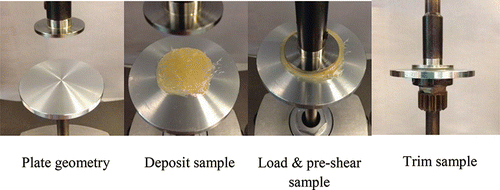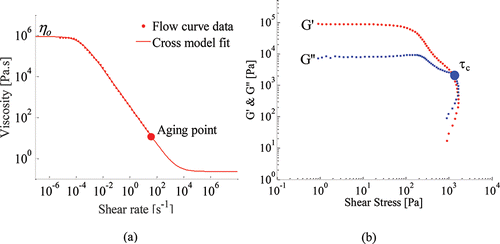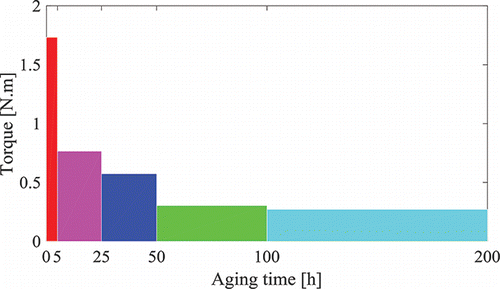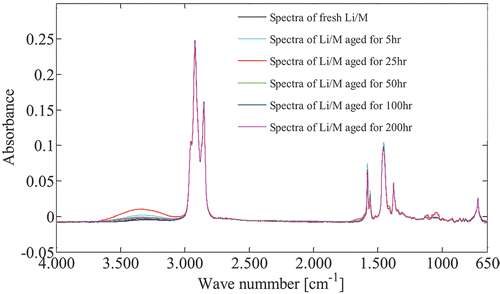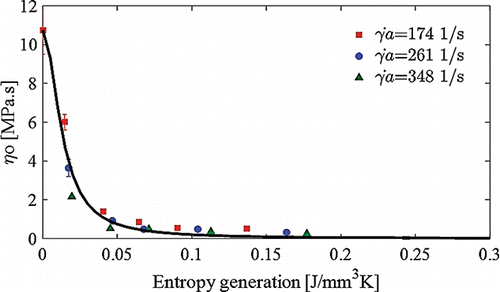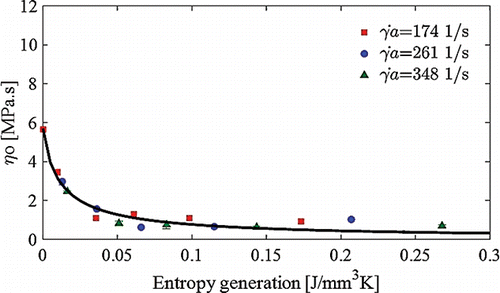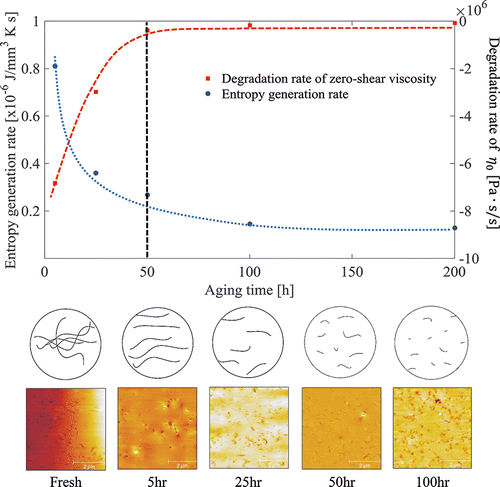ABSTRACT
In this article, the shear degradation of lithium 12-hydroxy stearate grease will be measured using an in-house-developed Couette aging machine. In this device the shear rate is well defined. The aging is related to the generated entropy density as described in Rezasoltani and Khonsari's work (Tribology Letters, Vol. 56, No. 2, pp. 197–204, 2014). The rheological properties of the aged samples were evaluated using a parallel-plate rheometer. The results showed that there are two aging phases with different degradation rates: a progressive degradation phase at the early stage, followed by a rather slow deterioration afterwards. Based on this observation, an aging equation was formulated to describe the aging behavior of lithium-thickened grease. Atomic force microscopy results of the fresh and aged greases showed that the variation in thickener microstructure provides a good explanation for the lithium grease degradation mechanism: under shear, the original fibrous network is progressively destroyed and becomes fragmented, leading to the loss of consistency and a change in the rheological properties.
KEYWORDS:
Nomenclature
| = | Average load per stroke inside the grease worker ( | |
| = | Frequency for the oscillatory test ( | |
| = | Storage modulus ( | |
| = | Loss modulus ( | |
| = | Gap height of the aging machine ( | |
| = | Coefficient of degradation | |
| = | Average thickener fiber length ( | |
| = | Piston displacement for one full stroke of the grease worker ( | |
| = | Degradation exponent | |
| = | Goodness of fit | |
| = | Surface roughness of the measuring plates (centre line average, | |
| = | Radius of the rotating bob ( | |
| = | Radius of the stable housing case ( | |
| = | Generated entropy per unit volume during aging ( | |
| = | Entropy generation rate per unit volume during aging ( | |
| = | Generated entropy per unit volume inside the grease worker ( | |
| = | Generated entropy per unit volume during preshear ( | |
| = | Ambient temperature of the grease worker ( | |
| = | Temperature during preshear ( | |
| = | Grease volume inside the Couette aging rig ( | |
| = | Grease volume inside the grease worker ( | |
| = | Work applied inside the grease worker ( | |
| = | Second stage rheological value after infinitely long aging | |
| = | Initial rheological value for fresh grease | |
| = | Aging shear rate ( | |
| = | Shear rate for preshear ( | |
| = | Cone penetration depth ( | |
| = | Zero shear rate viscosity ( | |
| = | Grease viscosity after infinitely long aging ( | |
| = | Base oil viscosity ( | |
| = | Initial zero shear viscosity for fresh grease ( | |
| = | Grease viscosity at the aging shear rate | |
| = | Shear stress within the aging gap ( | |
| = | Crossover stress ( | |
| = | Shear stress during preshear ( | |
| = | Yield stress obtained from the Herschel-Bulkley model ( | |
| = | Yield stress obtained from the oscillatory strain sweep test ( | |
| = | Thickener volume fraction | |
| = | Rotational speed of the aging machine ( |
Introduction
Grease is a widely applied lubricant mostly used in rolling bearings. It is a multiphase system consisting of three parts: thickener (3–30%), base oil (70–90%), and additives (Lugt Citation(1)). As a semisolid material, grease has a high consistency, which prevents leakage and creates a reservoir of lubricant inside the bearing. However, when subjected to the severe conditions within a rolling bearing, grease will undergo high shear, possibly causing deterioration. The degradation of this grease is usually reflected by the loss of its original consistency (softening), possibly yielding leakage from the bearing and, hence, starvation. It may also lead to continuous churning and high temperature. Both cases result in a reduced life of the bearing (Lugt Citation(1)). It is therefore valuable to investigate the mechanism of grease degradation and to develop predictive models for this.
Generally, the degradation of grease is classified as chemical or mechanical aging. This article focuses on the mechanical aging of lithium 12-hydroxystearate–thickened grease. This type of grease takes the major share of the worldwide industrial grease market and is widely applied in rolling bearings due to its wide temperature applicability, relatively good mechanical stability, water-resistant properties, and low cost (Lugt Citation(1)).
The most straightforward way to study grease aging is to obtain data from field tests directly, where the grease is worked in a real bearing (Salomonsson, et al. Citation(2)). Such field practice requires a long timescale study. For example, in the work of Lundberg and Höglund Citation(3), aged samples were collected from the wheel bearings of railway wagons after years of service. Another drawback of this method is the fact that it is practically impossible to estimate the exact aging conditions—that is, the shear stress/rate, temperature, and time—to which the sample was subjected during operation.
Currently, there are two standards for measuring grease degradation. One is the mechanical stability test where normal load and shear are applied; this is considered particularly meaningful in the situation where the bearing is subjected to vibrations and where the grease is continuously thrown back into the tracks. A typical mechanical stability test is the roll stability test (ASTM D 1831), where grease is sheared between a heavy roller (with a lead core) and a hollow rotating cylinder at an elevated temperature (generally 80°C). It was found that this test can be used to simulate the practical working conditions in automobile wheel bearings (Bondi, et al. Citation(4); Moore and Cravath Citation(5)), and rolling bearings in railway wagons (Lundberg Citation(6); Lundberg and Berg Citation(7)). The other test is the shear stability test, where only shear is applied. This is considered important for bearings running under relatively stable working conditions. When subjected to continuous shear, it is observed that shear degradation of the grease results in the release of oil and thus provides lubricant replenishment (Mérieux, et al. Citation(8); Cann, et al. Citation(9)). In the “grease worker” (ASTM D 217), which consists of a closed cylinder and a piston plate with a number of holes, the grease is sheared through the holes during a well-defined number of strokes (usually 10,000 or 100,000 strokes).
The drawback of the two ASTM aging methods mentioned above is that the applied shear condition is not well defined, which makes it difficult to use these methods for the development of predictive aging models. To measure aging as a function of shear and time, a modified Couette rheometer was used in the shear measurements of grease by Paszkowski Citation(10). Rezasoltani and Khonsari Citation(11) made use of a parallel-plate rheometer for the long-term shear tests of lithium-thickened grease. Aging in a rheometer provides a controlled aging process, where the rheology can directly be measured as a function of time. However, the disadvantage of a parallel-plate configuration is that the shear field within the gap is not uniform, resulting in an inhomogeneous aging condition. In addition, in the current rheological study, leakage was observed in the parallel-plate geometry due to the centrifugal forces and in the open Couette configuration due to the Weissenberg effect (Schramm Citation(12)). Hence, at some point during aging, the measurement will become inaccurate. Therefore, more robust test rigs are required.
Rezasoltani and Khonsari Citation(11) discovered a linear relationship between the energy input and the grease properties during grease aging tests using a parallel-plate rheometer. They mentioned that this “linear correlation remains valid regardless of the applied shear rate or the grease temperature” (p. 200). This was verified using a journal bearing mounted between two rolling bearings to provide a uniform film along the circumference of the journal bearing (hence the journal bearing was not loaded) and a modified grease worker. The experimental data of the journal bearing test rig showed a slight deviation from the linear relation obtained from the rheological measurements at the end of their experiments, which was ascribed to grease separation from the journal and a slippage effect during the tests.
The aim of the current study is twofold: the first objective is to follow up on the work of Rezasoltani and Khonsari Citation(11). The influence of grease mechanical degradation on its shear stability will be evaluated under similar aging conditions using lithium-thickened grease samples but with an increased aging period, hence increasing the total amount of entropy generated. The second goal is to study the underlying mechanism responsible for the aging of lithium grease.
To achieve the first task, fresh greases will be sheared in an in-house-made Couette aging machine at specific shear rates for a set period of time. Then the grease is sampled and its rheological properties are measured. Though lubricating grease can be considered chemically stable at low temperatures (Ito, et al. Citation(13), Fourier transform infrared spectroscopy (FTIR) measurements will be performed for the fresh and aged samples to confirm this. The physical processes occurring during mechanical degradation will be studied by measuring the change in the microstructure of the aged samples using atomic force microscopy (AFM).
Materials and method
Two commercial lithium-thickened greases, Li/M and Li/SS, were used. Information on their composition is presented in (Cyriac, et al. Citation(14)).
Table 1. Composition and properties of the greases studied.
Aging tests
Test rig
In the current study, the grease has been aged by means of applying specific shear rates for a set period, similar to what is done in a grease worker. However, the shear rate is now well defined. Normal load (or hydrostatic pressure) will not be applied at first (so only the shear stability of the grease will be studied). The grease should be aged in a closed system, where leakage is avoided. Another requirement for the new test rig is that a sufficient amount of aged grease can be collected for subsequent rheological tests.
The new test rig (called a Couette aging test rig) is shown in . The basic concept is analogous to a cylindrical viscometer: the grease is to be sheared between a stationary housing case and a rotating bob, which is driven by a motor and a belt transmission. The shear rate exerted over the grease can thus be calculated based on the input rotational speed and the geometry of the aging head. The temperature during the aging procedure is captured by the thermocouple at the end of the aging head. To prevent grease leakage due to the Weissenberg effect, a lip seal is mounted on top of the aging gap. The rig was designed for a grease sample volume of for each aging test (where
, leaving a 2-mm gap between the rotating bob and the housing case).
Aging condition
The aging rotational speeds are selected such that the imposed shear rates are similar to those applied on the aging tests performed by Rezasoltani and Khonsari Citation(11). The input rotational speeds, corresponding shear rates, and aging periods are listed in .
Table 2. Aging condition for Li/M and Li/SS.
Sampling
The lip seal (see ) generates a moderate amount of frictional heat, leading to a temperature gradient in the vertical direction. Together with possible thickener–oil separation due to shear, the thickener of the aged grease might no longer be evenly distributed inside the aging gap. The aged samples were therefore mixed for 500 strokes in an in-house-made grease worker before the rheological measurements were performed.
Rheological measurements
Rheological measurements were performed for the fresh and aged grease samples using an MCR 501 Anton-Paar rheometer with parallel plate configuration. The viscosity was measured by steady-state flow curve measurements. In addition, oscillatory strain sweep measurements were performed to measure the grease's viscoelastic properties.
Preparation
There are three major concerns during rheological measurements: wall slip, loading history, and edge effects. To reduce the influence of wall slip, measuring plates with rough surfaces are recommended (Czarny Citation(15); Paskowski Citation(16)). Therefore, the plates were roughened by sand-blasting (top plate: ; bottom plate:
). To minimize the initial deviation induced by the placing and loading procedure, the grease samples were first deposited on the bottom plate and the top plate descended at a controlled speed until the measure position was reached, leaving a 1-mm measuring gap. Thereafter, preshear following a DIN standard (Deutsches Institut für Normung Citation(17)) was applied (preshear at
for
at
). Subsequently, the accumulated grease at the plate periphery was carefully removed with a spatula. The loading and pre-shear procedure is illustrated in .
As a thixotropic material, regeneration of the thickener microstructure occurs after shearing the grease (Paszkowski Citation(16); Paszkowski, et al. Citation(18)). Therefore, before data collection, sheared grease is left to rest for a sufficient relaxation time. This duration will depend on the grease microstructure, thickener concentration, preshear condition, etc., and can be determined by a time sweep measurement.
Here, the time dependency of the shear modulus was recorded while imposing an oscillatory shear well within the linear viscoelastic regime (the applied shear is sufficiently small to not disrupt the grease properties). The detailed procedure is as follows: after preshear, a 2-h oscillatory test was applied at a constant shear stress of , oscillation frequency
, and temperature
. Both Li/M and Li/SS show a similar trend: the highest recovery of G′ takes place during the first hour of relaxation and the value levels out afterwards, which is in agreement with the literature (Paszkowski, et al. Citation(18)).
As a consequence, a relaxation time of 60 min was applied prior to the tests. The application of pre-shear and sufficient relaxation guarantees that the deviation in the following rheological results can be controlled within a spread, which satisfies the requirements for grease rheological measurement specified in DIN 51810-2 (Deutsches Institut für Normung Citation(17)).
Flow curve and oscillatory strain sweep measurement
Once the sample was prepared following the procedure described above, rheological tests were conducted. The flow curve measurement was performed at , with the shear rate increasing from
up to
. The oscillatory strain sweep measurement was performed at
, at a frequency of 1 Hz, with the shear strain sweeping from
to
. Each type of measurement was repeated at least twice. The repeatability of both flow curve and oscillatory strain sweep measurements was calculated based on the deviation from the average value of the duplicated test results; see .
Table 3. Repeatability of the rheological measurements.
Data process
Rheological output
Two representative results for both flow curve and oscillatory strain sweep measurements are presented in . As shown in , the flow curve measurement shows shear thinning of grease under continuously increasing shear. A zero-shear viscosity was obtained using the Cross model fit (Cross Citation(19). In , the storage modulus G′, loss modulus G″, and crossover stress
are obtained from the plot directly and the yield stress
was calculated using the method described by Cyriac, et al. Citation(20).
Entropy generation calculation
The entropy generated per unit volume during aging () will be calculated based on the estimated frictional energy generated by the grease and recorded temperature during the aging process following the approach proposed by Rezasoltani and Khonsari Citation(11).
If chemical reactions are neglected, the mechanical degradation of grease is such a slow process that “the major portions of the system are in homogeneous states that change slowly enough with time” (Rezasoltani and Khonsari Citation(21), p. 3). In this case, the entropy generated is equal to the accumulated energy divided by the aging temperature, which is produced through the absorption of heat (Tolman and Fine Citation(22)).
The recorded temperature showed that during aging, the variation in aging temperature was smaller than and the change in the system's internal energy was negligible compared to the energy accumulated during aging. Therefore, the accumulated energy is equal to the work exerted on the grease; that is, the integration of the grease frictional torque and the rotational speed over the aging time (Rezasoltani and Khonsari Citation(21). The entropy generated per unit volume
can thus be expressed as
[1]
Here, is the input rotational speed,
is the aging time, and
is the grease volume inside the Couette aging rig. In the current rig, the torque generated by the grease cannot be recorded directly and is calculated using the shear stress
acting over the area
at a distance
from the central axis (Godec, et al. Citation(23):
[2]
Here, is the applied shear rate presented in and
is the grease's apparent viscosity at the aging shear rate. The geometrical notations in Eq. [Equation2
[2] ] are shown in . During the aging process, the grease's apparent viscosity is not constant. To obtain the viscosity at the aging shear rate (
), grease samples were collected after each aging period. Flow curve measurements were performed on these samples, from which the
was estimated from a Cross model fit. An example of this
is displayed as the aging point in .
In this way, the torque during the aging process can be calculated periodically. As an illustration, shows an example of the torque distribution where Li/M was aged at 83 rpm for 200 h. The accumulated energy and the corresponding entropy generation density can be calculated by integrating the torque distribution over the aging period using Eq. [Equation1[1] ].
The work and entropy induced by the 500 strokes mixture within the grease worker was calculated based on Rezasoltani and Khonsari's Citation(11) method: the entropy generated inside the grease worker is equal to the applied work divided by the ambient temperature
, where
is the product of the average load and the piston distance for one stroke multiplied by the number of strokes (500).
The average load for one stroke (both tension and compression) during the pre-shearing, recorded by a load cell mounted beneath the cylinder of the grease worker, was
for fresh Li/M and
for fresh Li/SS. The piston displacement for one full stroke was measured as
. The volume of the grease sheared inside the cylinder was
and the ambient temperature
. The entropy generation per unit volume during the 500 strokes is thus calculated as
[3]
For Li/M, ; and for Li/SS,
.
In addition, the pre-shear procedure before the rheological measurement creates entropy. As specified in the Preparation section, the grease sample will be pre-sheared at for
at
. Based on the approach of Rezasoltani and Khonsari Citation(11), the entropy generation density during the preshear procedure
within the rheometer can be expressed as
[4] where
is the shear rate applied during preshear (
),
is the shear stress recorded during preshear,
is time, and
is the temperature during preshear (controlled at
).
For fresh Li/M, and for fresh Li/SS,
.
The entropy generation density during the sample preparation—that is, , is at least 100 times smaller than that generated during the aging test and can therefore be neglected. For the following study, only the entropy density generated during the aging tests
will be taken into account.
Aging mechanism investigation
The microstructure of the grease thickener is studied using atomic force microscopy (AFM) in dynamic tapping mode, which is widely applied on soft biological samples (Hoefnagels Citation(24)) and greases (Sanchez, et al. Citation(25); Paszkowski and Olsztyńska-Janus Citation(26)). The advantage of AFM over conventional scanning electron microscopy and transmission electron microscopy is that the soap structure can be observed without the need to remove the oil (Hurley and Cann Citation(27); Delgado, et al. Citation(28)). In addition, the sample preparation is limited to smearing a small volume of grease on a flat glass plate.
Results and discussion
Verification of chemical reaction
The FTIR spectra (limited wave number range of 4000–650 ) of fresh and aged Li/M are presented in . As an inhomogeneous material, grease thickener is not evenly distributed, resulting in the amplitude variation at zone 3500–3230 cm−1 (-OH bond),
(
asymmetric stretch), and
(-CH deformation), which indicates the difference in thickener concentration. However, no extra peaks are found between the fresh and aged samples' spectra; therefore, based on the detection accuracy of the current FTIR device, chemical reactions are not observed during the aging tests. A similar result was found for Li/SS. This was to be expected, because the maximum value of the recorded temperature during aging was low for the lithium-thickened greases (
for Li/M and 48
for Li/SS). Hence, the entropy calculation approach from Rezasoltani and Khonsari Citation(11) can be applied (Rezasoltani and Khonsari Citation(21)).
Thermodynamic characterization of grease mechanical degradation
In this section, the results from aging grease in the Couette aging rig will be presented and compared to those found by Rezasoltani and Khonsari Citation(11). As specified in the Methodology section, we used the same shear rates and the same definition of entropy as Rezasoltani and Khonsari Citation(11). However, they used the net penetration value as a response parameter, a measure of the consistency of a grease sample. To compare the current rheological values to Rezasoltani and Khonsari's Citation(11) results, a relationship between the penetration value and the yield stress was applied (Spiegel, et al. Citation(29)):[5] where
is the yield stress obtained from the flow curve data based on Herschel-Bulkley model (Spiegel, et al. Citation(29), and
is the cone penetration depth (
mm).
Rezasoltani and Khonsari Citation(11) did not use the standard ASTM method to measure the penetration depth. However, it is assumed that they scale similarly. As listed in , 15 samples were prepared and examined for the effects of each type of grease on aging. The calculated penetration depth of Li/M against entropy generation density is presented in , together with the data rebuilt from the results of Rezasoltani and Khonsari Citation(11) ().
Figure 6. Comparison of penetration values against entropy generation density during the aging process: (a) reproduced from Rezasoltani and Khonsari Citation(11) and (b) results from the current study (Li/M).
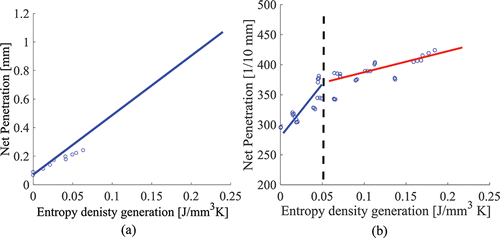
In the present case (), a linear relationship can be observed in the early stage of aging process; that is, . After this, the degradation behavior changes. Again a linear behavior is observed but with a different slope. The results from Rezasoltani and Khonsari Citation(11) also show a deviation from the linear fit at higher values of entropy density. However, this was less pronounced. The aging behavior shown in can be translated into a fast deterioration phase at the early stage and a slower deterioration phase afterwards.
and show the variation in the zero-shear viscosity with entropy generation per unit volume for Li/M and Li/SS, respectively, when subjected to three different shear rates. Again two phases can be seen: a progressive degradation in the first stage followed by a rather slow deterioration afterwards. This agrees with the penetration depth variation against entropy generation per unit volume illustrated in . Similar trends were also found from the literature survey (Plint and Alliston-Greiner Citation(30); Spiegel, et al. Citation(31); Kuhn Citation(32)).
The viscosity versus entropy generation trend of lithium-thickened grease is similar to the viscosity versus shear rate (shear thinning) behavior of lubricating greases. At relatively low shear (or energy), the grease has an initial high viscosity (here indicated as ). However, when mechanical degradation starts, the sample begins to soften and after being subjected to a certain amount of entropy (
), the viscosity levels out again with a weak degradation rate.
Therefore, the formula of the Cross equation (Cross Citation(19)), which is used to describe shear thinning behavior, was borrowed to describe the relationship between the variation in zero-shear viscosity and the entropy generation density during aging:[6] where
is the initial zero-shear viscosity for fresh samples, and
is the viscosity for infinitely long shearing, which is calculated using Batchelor's equation,
(Barnes, et al. Citation(33); the base oil viscosity
and the phase volume
are tabulated in ;
is the generated entropy per unit volume during aging,
is the coefficient of degradation, and
is the exponent of degradation.
Equation [Equation6[6] ] fits the data obtained from all three shear rates very well (
); see and . This model has also been applied to the other three selected rheological properties: storage modulus
, crossover stress
, and yield stress
from the oscillatory test in the form of Eq. [7], called here the grease aging equation:
[7] where
represents the rheological properties,
represents the initial rheological value for fresh grease,
represents the second-stage value for the long time–aged sample, and
and
are the coefficient of degradation and the exponent of degradation, respectively.
Each grease will have its own aging master curve, or grease aging equation, with its specific parameters; see .
Table 4. Parameters for the grease aging equation.
Grease aging mechanism
The generation of entropy demonstrates a dissipative process, which brings disorder to the system and, in this case, probably the collapse of the grease's microstructure. According to the literature, the consistency and rheological properties of fibrous structured greases are closely related to the geometry and distribution of the network structure formed by the fibers (Bondi, et al. Citation(4); Moore and Cravath Citation(5); Sanchez, et al. Citation(25); Yoshiyuki, et al. Citation(34)).
As shown in , there are two aging phases with different degradation rates. According to Bryant, et al. Citation(35), the entropy generation rate is closely related to the system degradation rate. Here the system degradation rate is measured by the changes in rheological properties per unit of time (macroscopically) and the change in the thickener network (microscopically). The entropy generation rate per unit of volume can be expressed as[8]
The entropy generation rate per unit volume and the degradation rate of the zero-shear viscosity for Li/M during the aging tests are plotted against aging time in . AFM measurements of the grease were taken at different points in time and are also shown in . The cartoons are interpretations of the AFM pictures, which will help in the explanation of the results.
shows the entropy generation rate, rheology, and microstructure of Li/M during aging. Although only the degradation rate for zero-shear viscosity is shown, the plots for crossover stress, storage modulus, and yield stress are very similar. The thickener microstructure for fresh Li/M is visualized as a twisted fibrous network where the fibers are typically 0.1–0.2 μm wide and up to long. Initially the sample shows high consistency. When the mechanical degradation is initiated, energy is dissipated into the system (high
), disrupting the network crosslinks and aligning the fibers (as presented in the first two cartoon and AFM results). This results in a fast degradation in grease properties. This stage can be characterized by the coefficient of degradation
(values of
are listed in ) and it ends when the fibrous network becomes fragmented (until 50 h, as shown in ).
After this fast degradation stage, the aged sample becomes a mixture of particle-like microfragments of thickener (with an average length of ) dispersed in the oil, and the deterioration process slows down (the degradation rate is approaching zero after 100 h of aging; see ). Such behavior suggests that once the fibrous structure is completely destroyed, the grease rheology will become stable. With the deceleration of the aging process, the entropy generation rate becomes smaller and remains constant.
However, the existence of microfragments (or ‘nano size thickener fibers’ termed by Yoshiyuki, et al. Citation(34)) still gives the aged grease a higher consistency compared to that of the bled oil (see the second-stage values for the aged samples presented in ). According to the R2F bearing tests performed by Cann, et al. Citation(9), small volumes of viscous liquid were found in the cage pockets, which was assumed to lubricate the rolling track; infrared spectroscopy showed that this lubricant was a mixture of oil and thickener, and more viscous liquid was found along with the running. Such viscous liquid can be considered as the aged grease at the second stage, where it has both better flowability compared to the fresh grease (for lubricant replenishment) and higher viscosity compared to the base oil (for film construction).
Spiegel, et al. Citation(31) described the fragmented thickener as spherical particles and modeled the second-stage mechanical aging using a Wöhler curve. Their theory suggests that when subjected to continuous shear, these spherical particles start rolling and the governing aging mechanism is fatigue. Considering the results shown in , in the second stage, the thickener structure has become fragmented during the second phase and the grease ages at a slower rate compared to the first aging phase. Currently, the grease rheology during aging is assumed to end up at an infinite value as shown in and and . A similar aging mechanism is also observed for Li/SS. To confirm Spiegel et al.'s Citation(31) theory, prolonged aging tests will be needed.
Conclusion
In this study, the mechanical shear degradation of lithium-thickened grease was evaluated using an in-house-developed aging rig and a commercial rheometer. It was found that this grease loses its original consistency during aging and shows a two-phase aging behavior. In the first phase, primarily reorientation and breakage of the thickener network take place, resulting in a progressive drop in the grease's rheological properties. After this, the aging is dominated by the breakage of smaller fiber fragments, and the grease degrades at a much slower rate (currently considered stable). A grease shear aging equation (Eq. [Equation7[7] ]) was introduced to describe such two-phase behavior. By making use of the entropy concept, this equation is capable of covering the change in grease's rheological properties when aged at different shear rates. This aging behavior is closely related to the entropy generation rate and the change in the thickener network during the aging process: due to breakage of the thickener structure, grease degrades, and the aging rate is positively correlated to the entropy generation rate. According to Rezasoltani and Khonsari Citation(11), the shear aging at various shear rates and temperatures can be described by a single (master) curve using the entropy concept. In the current study, the entropy concept was confirmed using aging at different shear rates. The current test rig does not make it possible to vary the aging temperature as well. It is therefore recommended to further study the impact of temperature on the shear aging behavior of grease.
Additional information
Funding
References
- Lugt, P. M. (2013), Grease Lubrication in Rolling Bearings, New York, NY, Wiley & Sons.
- Salomonsson, L., Stang, G., and Zhmud, B. (2007), “Oil/Thickener Interactions and Rheology of Lubricating Greases,” Tribology Transactions, 50(3), pp 302–309.
- Lundberg, J. and Höglund, E. (2000), “A New Method for Determining the Mechanical Stability of Lubricating Greases,” Tribology International, 33(3), pp 217–223.
- Bondi, A., Cravath, A. M., Moore, R. J., and Peterson, W. H. (1950), “Basic Factors Determining the Structure and Rheology of Lubricating Grease,” The Institute Spokesman, 13(12), pp 12–18.
- Moore, R. J. and Cravath, A. M. (1951), “Mechanical Breakdown of Soap-Base Greases,” Industrial & Engineering Chemistry, 43(12), pp 2892–2897.
- Lundberg, J. (2000), “Grease Lubrication of Roller Bearings in Railway Wagons. Part 1: Field Tests and Systematic Evaluation to Determine the Optimal Greases,” Industrial Lubrication & Tribology, 52(1), pp 36–43.
- Lundberg, J. and Berg, S. (2000), “Grease Lubrication of Roller Bearings in Railway Wagons. Part 2: Laboratory Tests and Selection of Proper Test Methods,” Industrial Lubrication & Tribology, 52(2), pp 76–85.
- Mérieux, J., Hurley, S., Lubrecht, A. A., and Cann, P. M. (2000), “Shear-Degradation of Grease and Base Oil Availability in Starved EHL Lubrication,” Tribology Series, 38, pp 581–588.
- Cann, P. M., Doner, J. P., Webster, M. N., and Wikstrom, V. (2001), “Grease Degradation in Rolling Element Bearings,” Tribology Transactions, 44(3), pp 399–404.
- Paszkowski, M. (2008), “Identification of the Thixotropy of Lithium Greases,” 16th International Colloquium Tribology, January 2008, Esslingen, Germany.
- Rezasoltani, A. and Khonsari, M. M. (2014), “On the Correlation between Mechanical Degradation of Lubricating Grease and Entropy,” Tribology Letters, 56(2), pp 197–204.
- Schramm, G. (1994), A Practical Approach to Rheology and Rheometry, Haake: Karsruhe, Germany.
- Ito, H., Tomaru, M., and Suzuki, T. (1988), “Physical and Chemical Aspects of Grease Deterioration in Sealed Ball Bearings,” Lubrication Engineering, 44(10), pp 872–879.
- Cyriac, F., Lugt, P., Bosman, R., Padberg, C., and Venner, C. (2016), “Effect of Thickener Particle Geometry and Concentration on the Grease EHL Film Thickness at Medium Speeds,” Tribology Letters, 61(2), pp 1–13.
- Czarny, R. (2002), “The Influence of Surface Material and Topography on the Wall Effect of Grease,” Lubrication Science, 14(2), pp 255–274.
- Paszkowski, M. (2013), “Assessment of the Effect of Temperature, Shear Rate and Thickener Content on the Thixotropy of Lithium Lubricating Greases,” Proceedings of the Institution of Mechanical Engineers - Part J: Journal of Engineering Tribology, 227(3), pp 209–219.
- Deutsches Institut für Normung. (2007), Testing of Lubricants—Determination of Shear Viscosity of Lubricating Greases by Rotational Viscosimeter—Part 1: System of Cone/Plate.
- Paszkowski, M., Olsztyńska-Janus, S., and Wilk, I. (2014), “Studies of the Kinetics of Lithium Grease Microstructure Regeneration by Means of Dynamic Oscillatory Rheological Tests and FTIR–ATR Spectroscopy,” Tribology Letters, 56(1), pp 107–117.
- Cross, M. M. (1965), “Rheology of Non-Newtonian Fluids: A New Flow Equation for Pseudoplastic Systems,” Journal of Colloid Science, 20(5), pp 417–437.
- Cyriac, F., Lugt, P. M., and Bosman, R. (2015), “On a New Method to Determine the Yield Stress in Lubricating Grease,” Tribology Transactions, 58(6), pp 1021–1030.
- Rezasoltani, A. and Khonsari, M. (2015), “Reply to Comment by Chung on ‘On the Correlation between Mechanical Degradation of Lubricating Grease and Entropy,’” Tribology Letters, 60(1), pp 1–4.
- Tolman, R. C. and Fine, P. C. (1948), “On the Irreversible Production of Entropy,” Reviews of Modern Physics, 20(1), pp 51–77.
- Godec, D., Malkin, A. Y., and Isayev, A. I. (2006), “Rheology—Concepts, Methods & Applications,” Polimeri, 27(1), pp 282–283.
- Hoefnagels, J. P. M. (2014), Overview of Microscopic Characterization Techniques, Eindhoven, The Netherlands, Eindhoven University of Technology.
- Sanchez, M. C., Franco, J., Valencia, C., Gallegos, C., Urquiola, F., and Urchegui, R. (2011), “Atomic Force Microscopy and Thermo-Rheological Characterisation of Lubricating Greases,” Tribology Letters, 41(2), pp 463–470.
- Paszkowski, M. and Olsztyńska-Janus, S. (2014), “Grease Thixotropy: Evaluation of Grease Microstructure Change Due to Shear and Relaxation,” Industrial Lubrication & Tribology, 66(2), pp 223–237.
- Hurley, S. and Cann, P. M. (2001), “Examination of Grease Structure by SEM and AFM Techniques,” NLGI Spokesman, 65(5), pp 17–26.
- Delgado, M. A., Franco, J. M., Valencia, C., Kuhn, E., and Gallegos, C. (2009), “Transient Shear Flow of Model Lithium Lubricating Greases,” Mechanics of Time-Dependent Materials, 13(1), pp 63–80.
- Spiegel, K., Fricke, J., and Meis, K. (1991), “Coherence Between Penetration and Flow Limit of Greases,” Tribologie und Schmierungstechnik, 38(6), pp 326–331.
- Plint, M. and Alliston-Greiner, A. (1992), “A New Grease Viscometer: A Study of the Influence of Shear on the Properties of Greases,” NLGI Spokesman, 56(2), pp 7–15.
- Spiegel, K., Fricke, J., and Meis, K. (2000), Die Fließeigenschaften von Schmierfetten in Abhängigkeit von Beanspruchung, Beanspruchungsdauer und Temperatur, International Colloquium Tribology: Esslingen, Germany.
- Kuhn, E. (1999), “Experimental Grease Investigations from an Energy Point of View,” Industrial Lubrication & Tribology, 51(5), pp 246–251.
- Barnes, H. A., Hutton, J. F., and Walters, K. (1989), An Introduction to Rheology, Amsterdam, The Netherlands, Elsevier.
- Yoshiyuki, S., Yusuke, N., Yusuke, I., Hiroki, S., and Yukitoshi, F. “Characterization of Nano Size Thickener Fiber in Grease by SAXS,” World Tribology Congress, 18–13 September, Torino, Italy.
- Bryant, M. D., Khonsari, M. M., and Ling, F. F. (2008), “On the Thermodynamics of Degradation,” Proceedings of the Royal Society of London A: Mathematical, Physical and Engineering Sciences, 464(2096).


